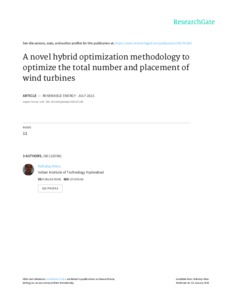Mittal, P and Kulkarni, K and Mitra, Kishalay
(2016)
A novel hybrid optimization methodology to optimize the total number and placement of wind turbines.
Renewable Energy, 86.
pp. 133-147.
ISSN 0960-1481
![[img]](http://raiithold.iith.ac.in/1873/1.hassmallThumbnailVersion/1873_Manuscript%20RG.pdf)  Preview |
|
Text (Author version post-print)
1873_Manuscript RG.pdf
- Accepted Version
Download (1MB)
| Preview
|
Abstract
Due to increasing penetration of wind energy in the recent times, wind farmers tend to generate increasing amount of energy out of wind farms. In order to achieve the target, many wind farms are operated with a layout design of numerous turbines placed close to each other in a limited land area leading to greater energy losses due to ‘wake effects’. Moreover, these turbines need to satisfy many other constraints such as topological constraints, minimum allowable capacity factors, inter-turbine distances, noise constraints etc. Thus, the problem of placing wind turbines in a farm to maximize the overall produced energy while satisfying all constraints is highly constrained and complex. Existing methods to solve the turbine placement problem typically assume knowledge about the total number of turbines to be placed in the farm. However, in reality, wind farm developers often have little or no information about the best number of turbines to be placed in a farm. This study proposes a novel hybrid optimization methodology to simultaneously determine the optimum total number of turbines to be placed in a wind farm along with their optimal locations. The proposed hybrid methodology is a combination of probabilistic genetic algorithms and deterministic gradient based optimization methods. Application of the proposed method on representative case studies yields higher Annual Energy Production (AEP) than the results found by using two of the existing methods.
Actions (login required)
 |
View Item |


 Altmetric
Altmetric Altmetric
Altmetric